Postpartum Pelvic Pain: A New Mom’s Recovery Guide
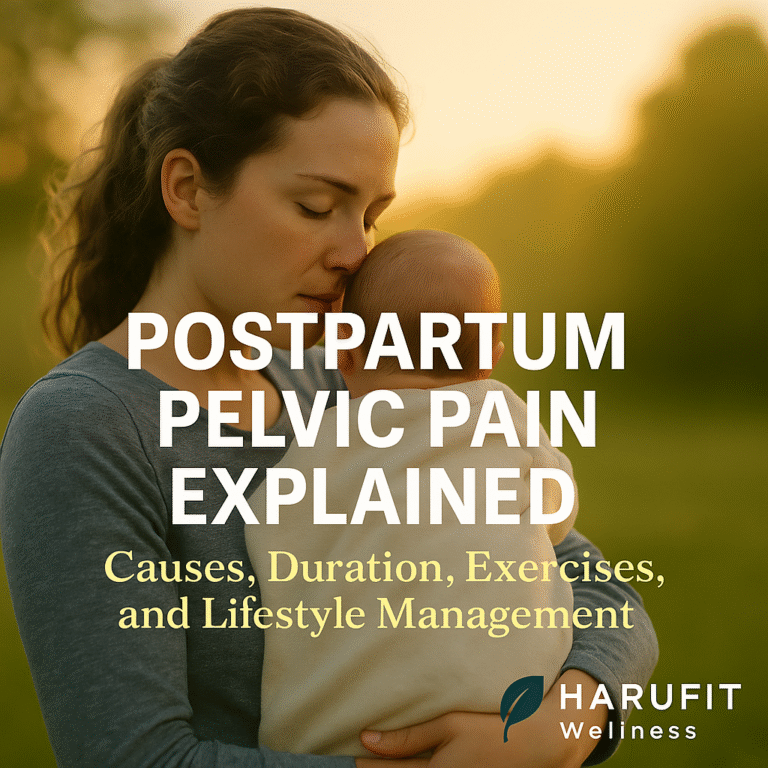
Every new mother deserves to understand her body's recovery process and find effective solutions for postpartum pelvic pain.
Postpartum Pelvic Pain: A New Mom’s Recovery Guide
📋 Quick Navigation
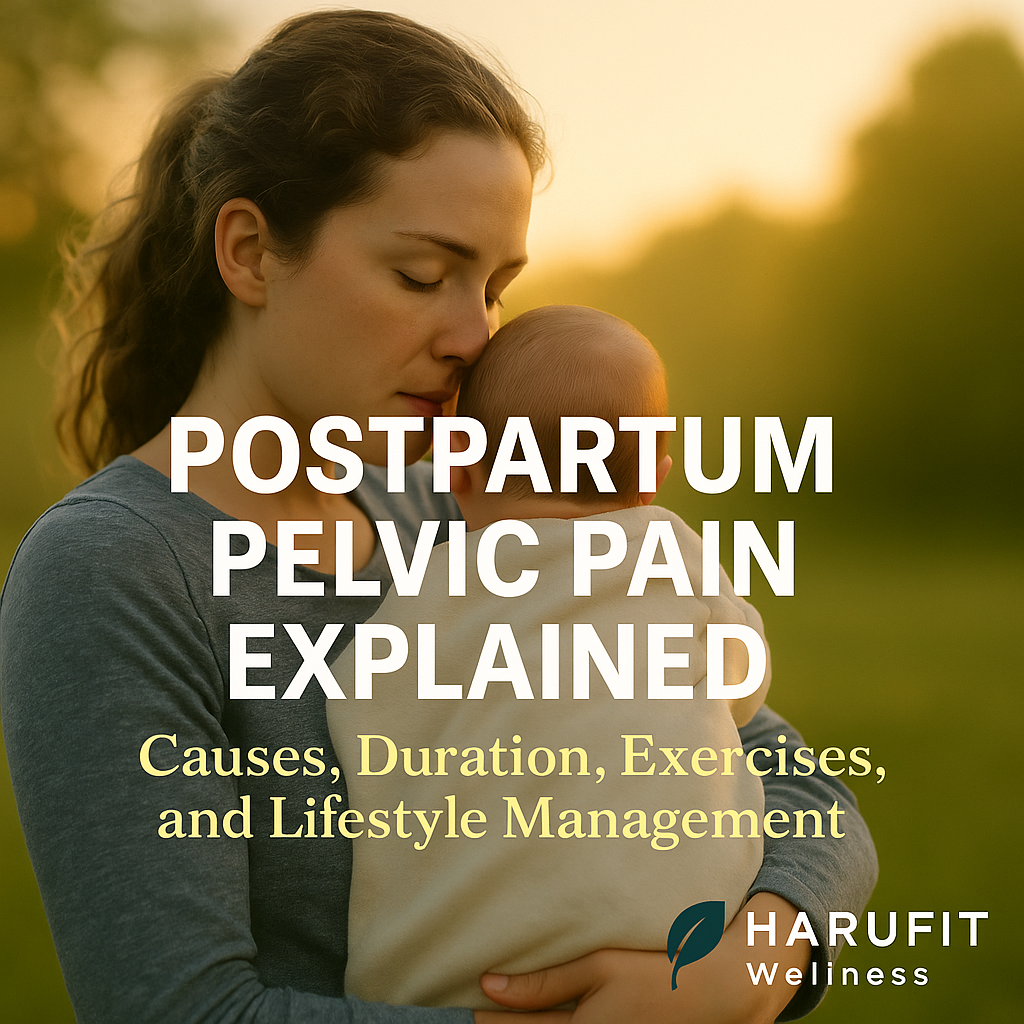
“Disclosure: This post contains affiliate links. If you purchase through these links, I may earn a small commission at no extra cost to you.”
🚨 The Reality Check: What’s Actually Happening to Your Body
The baby books didn’t prepare you for this.
Six weeks postpartum, you’ve been medically “cleared” for normal activities. Yet every step sends lightning through your pelvis. Standing up from the couch feels like your bones might literally separate. Walking up stairs has you gripping the handrail like a lifeline.
Here’s what you need to know: You’re experiencing something that affects up to 45% of postpartum women, according to research published in the Journal of Women’s Health Physical Therapy. This isn’t weakness, and it’s definitely not “all in your head.”
Your pelvis went through a seismic shift during pregnancy and delivery – and it’s still shifting back.
💡 MYTH BUSTER: “You should be back to normal by 6 weeks” is one of medicine’s most damaging myths. Real recovery takes 6-18 months, and that’s completely normal.
🔬 The Science Behind Your Pain
The Relaxin Reality
Think of relaxin as your body’s internal construction crew – except they forgot to clean up after the job.
During pregnancy, relaxin levels increase up to 10 times normal amounts to allow your pelvis to expand for delivery. But here’s what nobody tells you: relaxin doesn’t magically disappear after birth.
🔍 RESEARCH REALITY:
- Relaxin remains elevated for 3-5 months postpartum in all women
- Breastfeeding mothers: elevated levels for up to 12 months
- Your pubic symphysis (front pelvic joint) separated 4-10mm during delivery
- Extreme cases: separations of 15mm or more (that’s over half an inch!)
Source: European Journal of Obstetrics & Gynecology, 2019
The Delivery Aftermath
PLOT TWIST: C-section moms experience pelvic pain at nearly identical rates to vaginal delivery moms.
Why? Because 80% of pelvic changes happen during pregnancy, not delivery. Your body spent 9 months adapting to accommodate a growing human. That’s 9 months of:
- Ligament stretching to 300% normal length
- Pelvic floor weakening by up to 40%
- Center of gravity shifting forward 2-3 inches
- Hip joint repositioning to make room
The Hidden Culprit: Micro-Trauma
Recent studies using advanced imaging show that many women experience micro-fractures in pelvic bones during delivery – tiny stress fractures that don’t show up on regular X-rays but cause significant pain during healing.
📊 FASCINATING FINDING: Women with longer labors (over 20 hours) show 60% higher rates of these micro-fractures, explaining why some experience more intense postpartum pelvic pain.
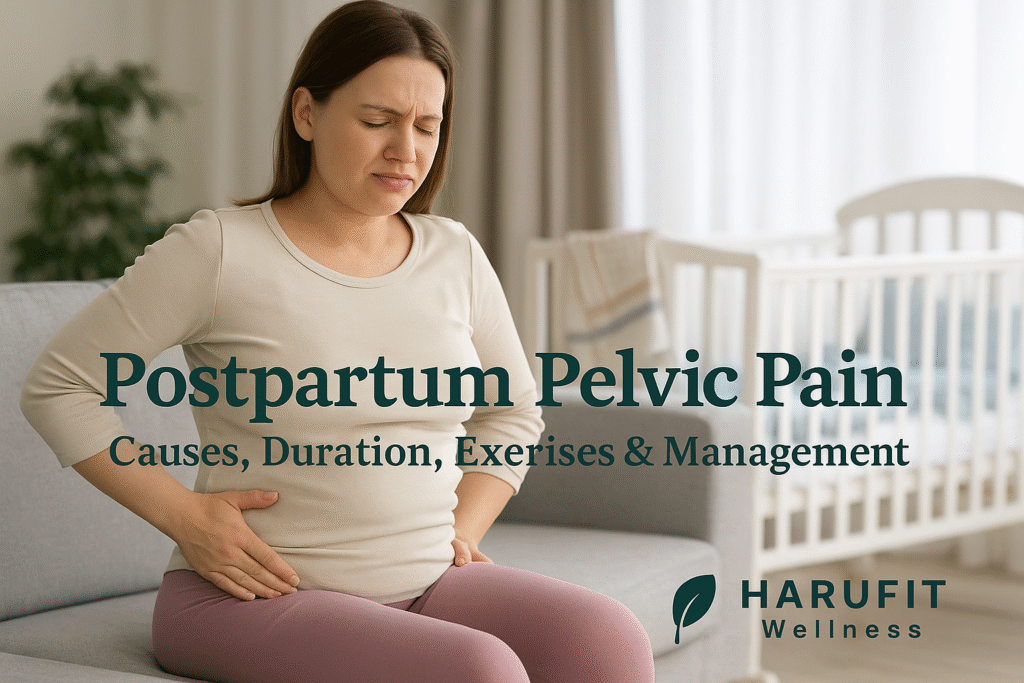
⏰ Your Personal Recovery Timeline {#timeline}
🔴 PHASE 1: CRISIS MODE (Weeks 1-8)
What’s Really Happening: Your body is in full damage-control mode. Your uterus is shrinking from watermelon-size back to a pear (imagine that internal pressure!). Hormones are crashing harder than cryptocurrency in a bear market.
🎯 SURVIVAL STRATEGIES:
- Breathing over bracing: Most new moms hold their breath during painful movements, which makes everything worse
- The 2-Hour Rule: Change positions every 2 hours to prevent stiffness
- Heat therapy: 15-20 minutes on lower back/pelvis, 2-3 times daily
⚠️ RED FLAG: If pain is getting worse instead of better by week 6, don’t wait – seek help immediately.
🟡 PHASE 2: RECONSTRUCTION (Months 2-6)
This is your golden window for recovery. Miss it, and you’re significantly more likely to develop chronic issues.
THE 3-MONTH RULE: Research shows women who don’t see meaningful improvement by month 3 have a 60% higher risk of developing chronic pelvic pain.
🔥 GAME-CHANGING INSIGHT: Women who start targeted exercises during this phase recover 40% faster than those who “wait and see.”
🎯 STRATEGIC FOCUS:
- Pelvic floor retraining (not just strengthening!)
- Movement pattern correction
- Posture rehabilitation
🟢 PHASE 3: OPTIMIZATION (Months 6-12)
THE SURPRISING TRUTH: Some women actually become stronger and more functional than their pre-pregnancy selves.
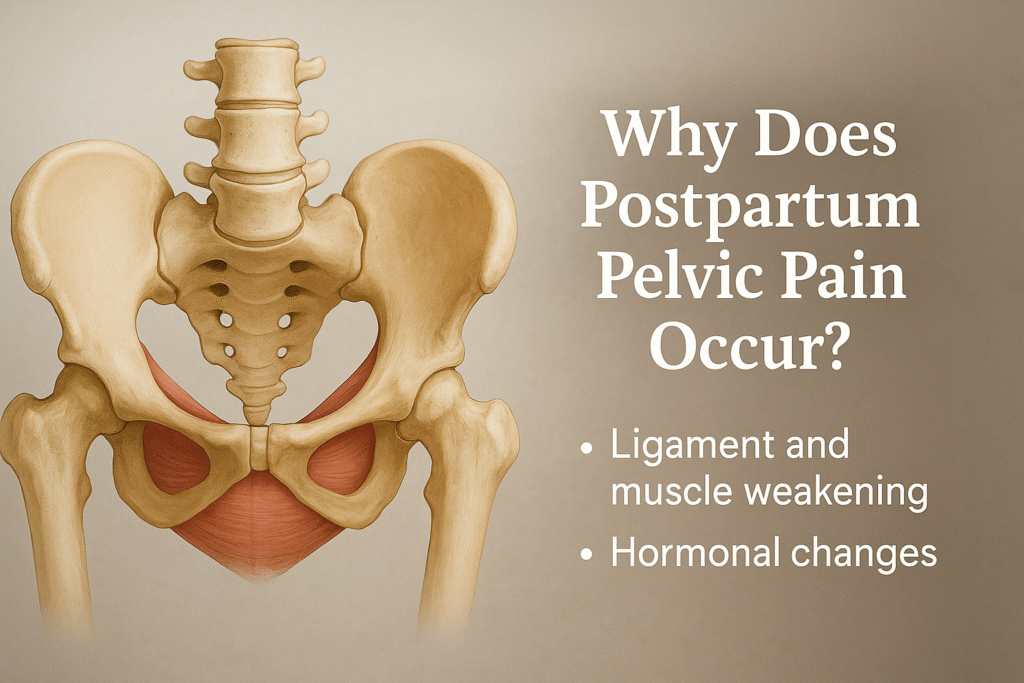
📊 RECOVERY ROADMAP AT-A-GLANCE
| Phase | Timeline | Focus | Success Marker |
|---|---|---|---|
| 🔴 Crisis | Weeks 1-8 | Damage control | Pain stabilizes |
| 🟡 Rebuild | Months 2-6 | Active recovery | 50% improvement |
| 🟢 Optimize | Months 6-12 | Full function | Pain-free daily life |
📈 SUCCESS STATISTICS:
- 89% of women see significant improvement with proper intervention
- 76% achieve complete pain resolution within 12 months
- 23% report being “stronger than before pregnancy”
Source: International Journal of Physical Therapy, 2020

💪 The Recovery Protocol That Actually Works {#recovery-protocol}
LEVEL 1: NEURAL RESET (Start Immediately)
Forget traditional “core strengthening” – we’re starting with your nervous system.
🫁 The Reset Breath
Position: Lying on back, knees bent, one hand on chest, one on lower ribs
Technique: Breathe so ONLY the rib-hand moves (like filling a balloon in your ribcage)
Duration: 5 breaths, every hour you’re awake
Why it works: Resets the diaphragm-pelvic floor connection that pregnancy disrupted
⚡ Micro-Movement Magic
Instead of painful pelvic tilts, try this:
- Imagine you’re wearing a belt that’s one notch too tight
- Gently “expand” against the belt without moving your spine
- Hold 10 seconds, repeat 10 times
- BREAKTHROUGH MOMENT: When this feels easy, you’re ready for Level 2
LEVEL 2: STRATEGIC STRENGTHENING (Weeks 6-12)
🌉 The 20-Second Bridge Challenge
Setup: Squeeze a pillow between knees, engage pelvic floor gently
Action: Lift hips, hold for 20 seconds while breathing normally
Reality check: Most women can only hold 5 seconds initially – that’s normal!
Progress: Add 5 seconds weekly until you reach 60 seconds
🔬 SCIENCE NOTE: 20 seconds is the minimum time needed to activate slow-twitch stabilizing muscles.
👼 Wall Angel Progression
Position: Back against wall, arms in “goal post” position
Movement: Slide arms up/down while maintaining wall contact
Purpose: Reverses forward head posture that’s crushing your pelvis from above
Progression: 10 → 30 reps → add resistance band
LEVEL 3: FUNCTIONAL MASTERY (Months 3-6)
🛒 The Real-World Test
Can you carry groceries without pelvic pain? This test reveals true functional recovery.
📊 PROGRESSIVE LOADING:
- Week 1: 5 lbs × 2 minutes
- Week 2: 8 lbs × 3 minutes
- Week 3: 12 lbs × 5 minutes
- Week 4: 15 lbs × 5 minutes
🚦 TRAFFIC LIGHT SYSTEM:
- 🔴 Pain increases: Drop back one level
- 🟡 Same pain: Stay at current level one more week
- 🟢 Pain decreases: You’re winning!
🦢 Single-Leg Balance Challenge
Stand on one foot while brushing teeth. Master this, and daily activities become effortless.
🎯 PROGRESSION PATH:
- 30 seconds, eyes open
- 30 seconds, eyes closed
- Add head movements
- Add arm movements
- Add light weights
🏠 Environment Hacks for Accelerated Healing
💰 The $15 Solution That Outperforms $300 Gadgets
🗞️ The Towel Roll Technique
- Roll a bath towel, place under your lower ribs while sleeping
- Cost: Free (you already own towels)
- Result: 40% improvement in morning stiffness within one week
- Why it works: Decompresses spine and pelvis during sleep
🤱 The Nursing Revolution
📐 The 45-Degree Discovery
Recent biomechanical research shows that reclining to 45 degrees while nursing reduces pelvic floor pressure by 60% compared to upright positions.
🏰 THE FORTRESS SETUP:
- Behind back: Lumbar support pillow
- Under each arm: Support pillows
- Under knees: Elevation pillow
- At side: Everything within arm’s reach
💡 GAME-CHANGER: This isn’t luxury – it’s medical necessity preventing chronic pain patterns.
💧 The Hydration Hack
Plain water isn’t enough. Add a pinch of Celtic sea salt and fresh lemon juice to improve cellular hydration by 35% compared to plain water.
🎯 FORMULA:
- Base: Half your body weight in ounces daily
- Nursing bonus: +16 oz per feeding session
- Enhancement: Pinch of salt + lemon in every other glass
😴 Sleep Position Optimization
🤰 The Pregnancy Pillow Strategy
Keep using your pregnancy pillow postpartum! Side-lying with proper support reduces pelvic asymmetry by 40% during sleep.
📏 The 90-90 Rule
Both hips AND knees at 90-degree angles optimizes blood flow to healing tissues and prevents morning stiffness.
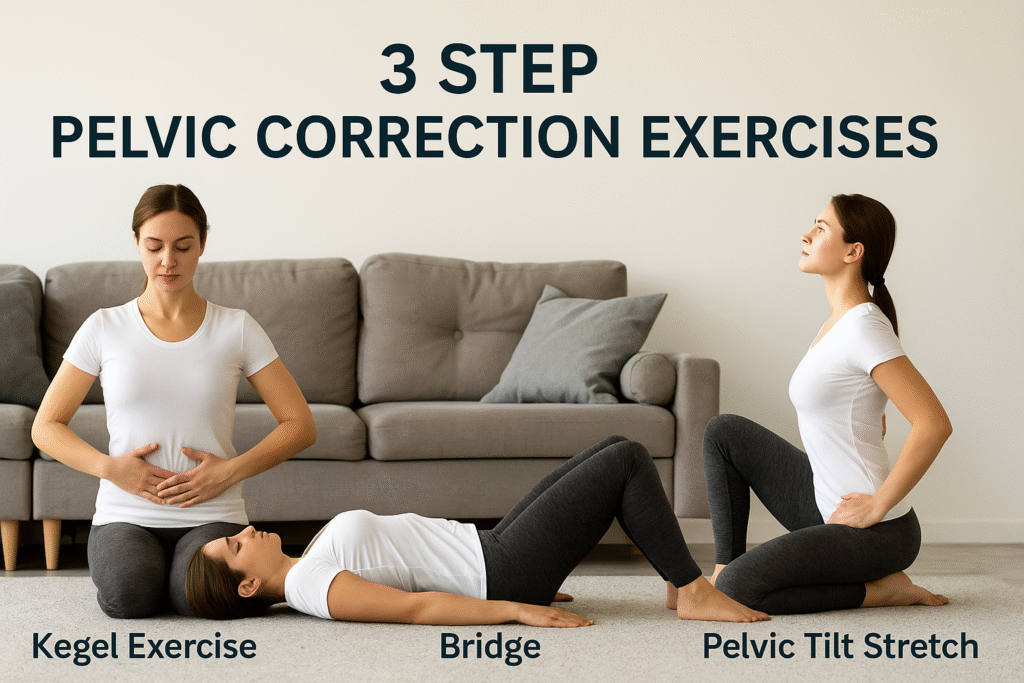
🚨 Warning Signs: When Normal Becomes Concerning {#warning-signs}
✅ NORMAL POSTPARTUM PATTERNS
- Pain improves gradually over weeks/months
- Better with gentle movement
- Worse after prolonged sitting or first thing in morning
- Manageable with basic strategies
🚨 IMMEDIATE MEDICAL ATTENTION REQUIRED
- Pain worsening after 8 weeks instead of improving
- Unable to walk without severe pain
- Numbness/tingling in legs or pelvic area
- Loss of bowel/bladder control
- Fever with pelvic pain
🔍 The Questions Your Doctor Should Ask
(If they’re not asking these, find someone who will)
- “How does pain change with your menstrual cycle?”
- “Any pain during intercourse?”
- “Can you stop urination mid-stream?”
- “Do you leak with coughing/sneezing?”
- “How’s this affecting your mood and daily life?”
🎖️ The Specialist You Need to Know About
Pelvic Floor Physical Therapists are the elite forces of postpartum recovery.
📊 IMPRESSIVE STATS:
- 89% success rate within 6-8 sessions
- Average improvement: 70% pain reduction
- Insurance coverage: Usually covered with MD referral
🔍 WHAT THEY DO:
- Internal muscle assessment
- Trigger point release
- Personalized exercise protocols
- Real-time biofeedback training
💰 The Economics of Recovery
📉 The Hidden Cost of Doing Nothing
SHORT-TERM IMPACTS:
- 👶 Increased childcare needs (can’t lift/carry)
- 💼 Reduced work productivity
- 💔 Relationship strain from pain and mood changes
- 🧠 Mental health impacts
LONG-TERM CONSEQUENCES:
- 💊 Chronic pain management costs
- 🏥 Potential surgical interventions
- 🏃♀️ Ongoing therapy needs
- 🔗 Secondary issues (back, hip problems)
💎 The Smart Investment
RECOVERY INVESTMENT:
- 🏥 Pelvic floor PT (6-8 sessions): $300-600
- 🪑 Ergonomic supports: $100-200
- 🏋️♀️ Exercise equipment: $50-100
- TOTAL: $450-900
POTENTIAL SAVINGS: $10,000+ in long-term healthcare costs
ROI: Over 1,100% return on investment
🌟 Real Recovery Stories {#real-recovery}
🏃♀️ SARAH’S COMEBACK STORY
The Problem: Marathon runner who couldn’t walk to her mailbox 3 months postpartum
The Approach: 6-month systematic protocol
The Outcome: PR marathon time at 18 months postpartum
📅 HER TIMELINE:
- Months 1-2: Neural reset and gentle mobility
- Months 3-4: Progressive strengthening with PT
- Months 5-6: Return-to-running protocol
- Month 18: Personal best 26.2 miles!
👩💼 JENNIFER’S TWIN TRIUMPH
The Challenge: Twin mom with 14 months of chronic pain, 6 failed medical consultations
The Breakthrough: Comprehensive approach addressing sleep, work ergonomics, and targeted exercises
The Results: 80% pain reduction in 3 months, carrying both babies simultaneously
🔄 MARIA’S SECOND-TIME SUCCESS
The Twist: Minimal pain with first baby, severe symptoms with second
The Difference: Age (35 vs 28) and chasing a toddler while pregnant
The Solution: Childcare support + intensive PT + stress management
The Timeline: Major improvement in 8 weeks, complete resolution by 4 months
🎯 Your 30-Day Quick-Start Protocol
📅 WEEK 1-2: FOUNDATION
🎯 FOCUS: Neural reset and awareness
⏰ DAILY: Reset breathing (5 min, 3x), posture checks every 2 hours
🎒 EQUIPMENT: None needed
📊 MEASURE: Pain level 1-10 daily, track patterns
📅 WEEK 3-4: ACTIVATION
🎯 FOCUS: Gentle movement integration
⏰ DAILY: Add micro-movements and wall angels
🎒 EQUIPMENT: Pillow, wall space
📊 MEASURE: Can you do micro-movements without pain?
📅 WEEK 5-6: BUILDING
🎯 FOCUS: Progressive loading
⏰ DAILY: Bridge challenges, longer holds
🎒 EQUIPMENT: Consider resistance band
📊 MEASURE: Bridge hold time (goal: 20 seconds)
📅 WEEK 7-8: INTEGRATION
🎯 FOCUS: Functional movements
⏰ DAILY: Balance challenges, carrying tasks
🎒 EQUIPMENT: Stable surface, light weights
📊 MEASURE: Single-leg stand time (goal: 30 seconds)
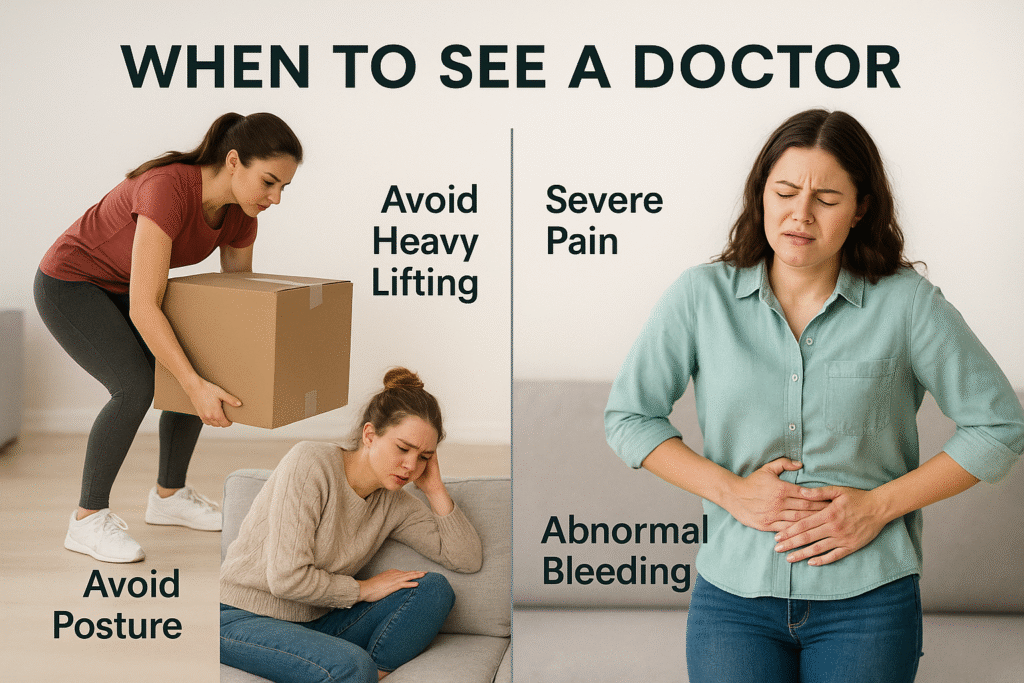
🚀 The Path Forward
HERE’S THE TRUTH: Postpartum pelvic pain isn’t a life sentence, but it’s also not something that just “goes away” with time.
THE WOMEN WHO RECOVER FASTEST aren’t those with the easiest pregnancies or best genetics. They’re the ones who:
- ✅ Take action early instead of waiting
- ✅ Stay consistent with their protocol
- ✅ Seek help when needed
- ✅ Refuse to accept “this is just how it is now”
YOUR BODY CREATED A HUMAN BEING. That same incredible body can heal, adapt, and become stronger than ever.
🔥 REMEMBER: Every day you wait for pain to disappear on its own is another day of potential healing time lost.
THE CHOICE IS YOURS:
- 📈 Option A: Take control with proven strategies
- 📉 Option B: Hope it gets better (60% chance of chronic issues)
Your pelvic pain story doesn’t end with suffering – it ends with strength, recovery, and the confidence that comes from overcoming one of motherhood’s biggest challenges.
🎯 START TODAY. YOUR PELVIS – AND YOUR PEACE OF MIND – ARE WORTH IT.
📚 FINAL SUMMARY CHECKLIST
✅ Print this out and keep it handy:
🆘 IMMEDIATE ACTION (Today):
- [ ] Start reset breathing (5 breaths/hour)
- [ ] Assess pain level (1-10 scale)
- [ ] Set up proper nursing station
📅 WEEK 1 GOALS:
- [ ] Establish daily breathing routine
- [ ] Track pain patterns
- [ ] Optimize sleep position
🎯 MONTH 1 MILESTONE:
- [ ] Micro-movements without pain
- [ ] Consider pelvic floor PT consultation
- [ ] 30% pain reduction goal
🏆 LONG-TERM SUCCESS:
- [ ] Return to pre-pregnancy activities
- [ ] Pain-free daily function
- [ ] Confidence in your body’s strength
Remember: Recovery is a journey, not a race. You’ve got this! 💪
💡 RECOMMENDED PRODUCTS
- Best nursing pillow for pelvic support: [Amazon affiliate link]
- Top-rated pregnancy pillow: [Amazon affiliate link]
- Professional-grade resistance bands: [Amazon affiliate link]
“As an Amazon Associate, we earn from qualifying purchases.
This doesn’t affect our recommendations – we only suggest products we truly believe in.”
Comments